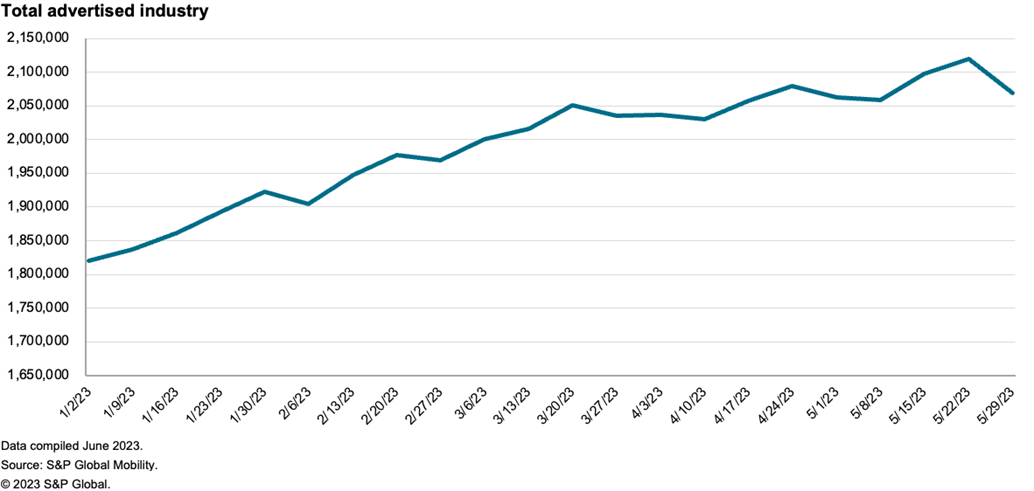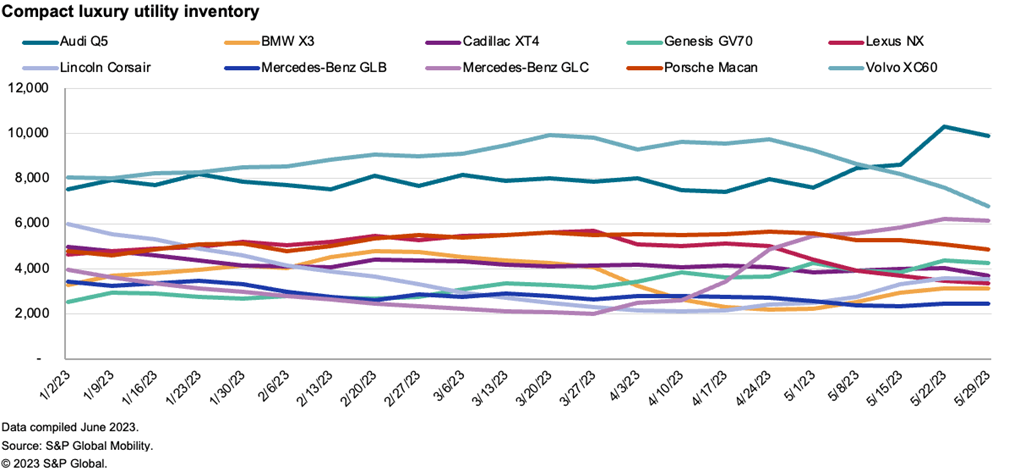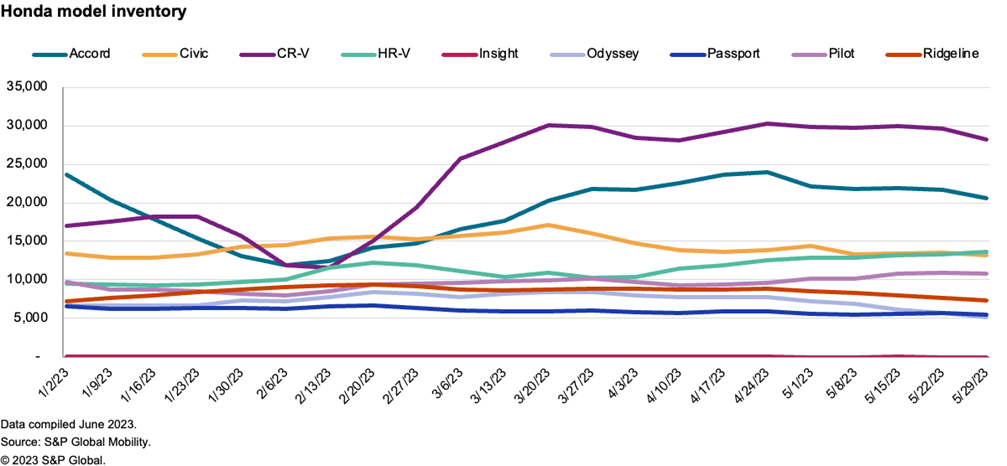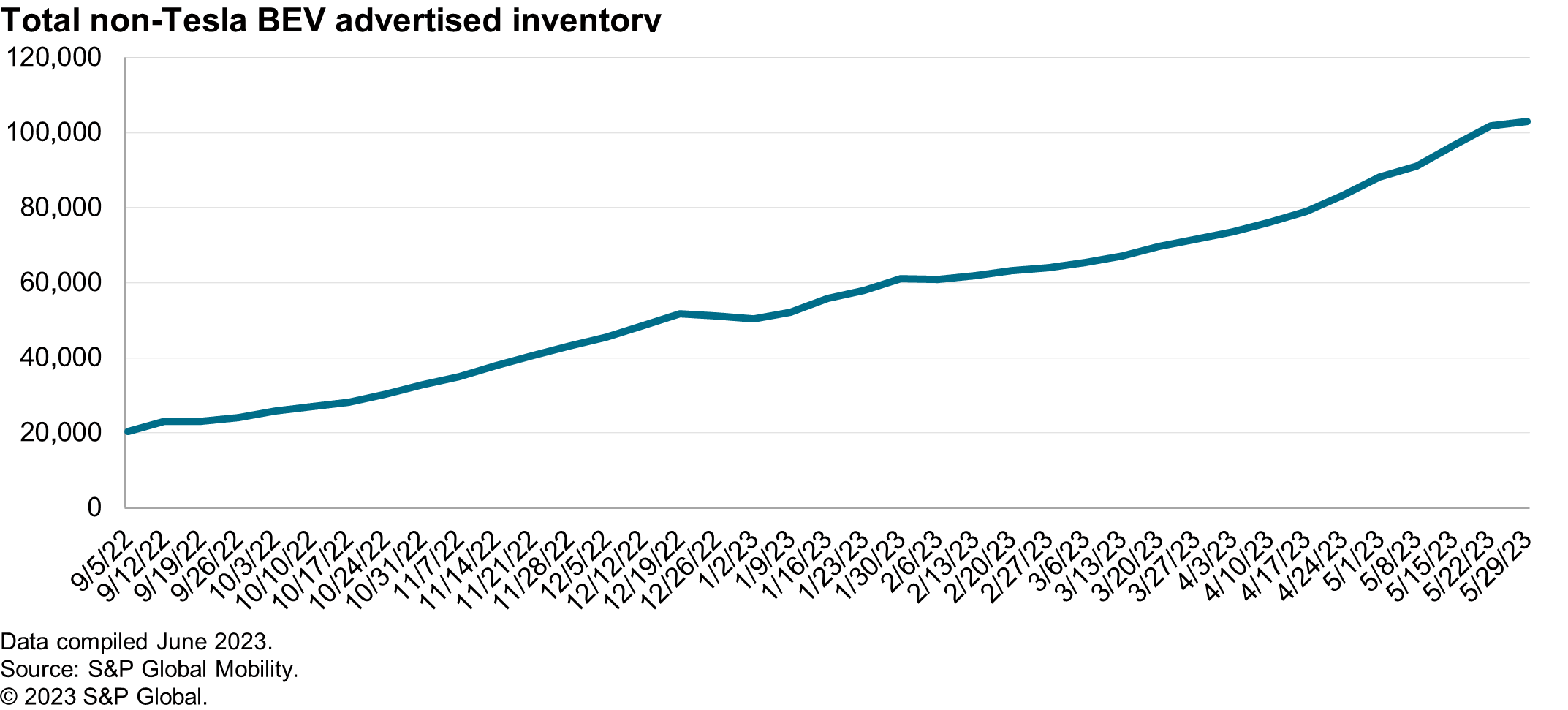Discover more about S&P Global's offerings
Customer Logins
Obtain the data you need to make the most informed decisions by accessing our extensive portfolio of information, analytics, and expertise. Sign in to the product or service center of your choice.
Customer Logins
BLOG
Jun 21, 2023
June auto inventory trends you should know
While dealer-advertised vehicle inventories continue their several-month trend of meandering around 2.050 million vehicles - though a startling 72% increase year-over-year - there are some discernable recent inventory trends based on S&P Global Mobility's data. While many brands continue to struggle to keep dealers supplied, others are seeing relief for the first time since the pandemic.

There has been a predictable rise and fall through the weeks of the
month since March - which hints at a return to a more normal or
predictable inventory flow. As dealers come under pressure to hit
volume targets, they accelerate sales at month's end, leading to
short supply in the first week of the new month, which then
restocks during the second and third week, leading once again to
month-end clearances. Here are some of the notable movers and
shakers in June inventories:
Compact Luxury Utility Vehicle dogfight

The European-brand luxury compact SUV market is heating up. The
Audi Q5 has seen its inventories jump sharply by 31% since January,
to about 9,900 units in June (a typical good sales month for the Q5
is between 5,500 and 6,000 units). Meanwhile, the redesigned 2023
Mercedes-Benz GLC is starting to arrive in showrooms in earnest,
after the selldown of the old model, and while inventories are
recovering somewhat, GLC stocks still remain in a valley. BMW X3
inventories remain flat. Meanwhile, Volvo is lurking with
substantial XC60 inventories, even though they have dipped since
March. This scenario may present Audi and Volvo with an opportunity
for conquest during the summer-sale season.
Honda CR-V, Accord launches

The redesigns of the top-selling Honda CR-V crossover and Accord
sedan put dealers in an inventory gulley as the old models sold
down, but stock is recovering quickly. Just a few months ago,
inventories for the CR-V were down to just 11,600 units in
mid-February (for a model that peaked at 384,168 units sold in
2019). As of the first week of June, CR-V inventories were a
healthy nearly-30,000-unit level. Same for the Accord: At about
11,900 units in mid-February; now at about 22,000. There is still
room to grow, but it seems sufficient to at least let consumers see
some variety on showroom floors.
Non-Tesla EVs entering the fray

The battery-electric scene is heating up, even without counting
Tesla. In mid-September, legacy-brand BEVs accounted for about
20,000 units. As of early-June, that number has leapt to more than
100,000 units - a five-fold increase in just nine months (and not
counting Rivian, Lucid, or Tesla). Of that inventory, 30% is in
California. Given that the
San Francisco Bay Area just cracked 50% electrified share in
March and April, that allocation should be little surprise.
Hyundai, Ford carrying most EV inventory

At the end of May, Hyundai had the most EVs in dealer advertised
inventory, at about 15,000 units. But the fast mover is Ford, which
passed Hyundai in early June. Perhaps maximizing the marketing
impact of its shared-charger arrangement with Tesla, Ford has
tripled its advertised inventories of the Mustang Mach-E in little
more than a month. By early-June, Mach-E inventories were at about
11,000 units - for a vehicle that has cracked the monthly
5,000-units-sold only once since launch, and which hasn't broken
3,000 units yet this year. This could be a sign that Ford is truly
entering the EV sales and share race. Not that VW is standing
still, as its ID.4 advertised inventories have doubled to 10,900
units since early in the year - with no signs the Chattanooga
factory is slowing down. On the flipside, at the beginning of the
year, the Chevrolet Bolt had the most inventory of any BEV; now
it's a distant fifth.
Ford ramping up F-150 for summer

There is a lot of action happening in full-size pickups. Chevrolet
tapping its production brakes by halting its Fort Wayne, Indiana,
truck plant for two weeks in late March had an immediate impact.
Although GM's three other full-size pickup plants in Mexico, Canada
and Flint kept on trucking, inventories have decreased from about
90,000 units to about 72,000 units in early June. For reference,
Chevrolet sold 87,111 units of the Silverado 1500 (light duty) in
the first quarter. Meanwhile, Ford full-size pickup inventories
continue to climb, from about 43,000 units a year ago to 115,000
units in early June. But F-Series sales are also charging, with
April and May marking the hottest back-to-back F-Series months
since before the pandemic, with more than 140,000 total units sold.
Third-place Ram continues to see relatively lower inventories; in
fact, premium branded GMC pickups now have nearly as many
advertised units as the Stellantis truck brand.
As the summer selling season approaches, how OEMs deal with suddenly surging inventories against brands still facing availability challenges will mark who will blink first in what could be a red-hot incentives war to gain precious market share.
LOWER-CREDIT BUYERS PUSHED OUT OF
NEW VEHICLES
THE AUTO INDUSTRY SHARE WARS WILL RESUME IN '23
AVERAGE VEHICLE AGE REACHES RECORD 12.5 YEARS
SUBSCRIBE TO OUR TOP 10 INDUSTRY TRENDS NEWSLETTER
This article was published by S&P Global Mobility and not by S&P Global Ratings, which is a separately managed division of S&P Global.
{"items" : [
{"name":"share","enabled":true,"desc":"<strong>Share</strong>","mobdesc":"Share","options":[ {"name":"facebook","url":"https://www.facebook.com/sharer.php?u=http%3a%2f%2fstage.www.spglobal.com%2fmobility%2fen%2fresearch-analysis%2fjune-auto-inventory-trends-you-should-know-.html","enabled":true},{"name":"twitter","url":"https://twitter.com/intent/tweet?url=http%3a%2f%2fstage.www.spglobal.com%2fmobility%2fen%2fresearch-analysis%2fjune-auto-inventory-trends-you-should-know-.html&text=June+auto+inventory+trends+you+should+know++%7c+S%26P+Global+","enabled":true},{"name":"linkedin","url":"https://www.linkedin.com/sharing/share-offsite/?url=http%3a%2f%2fstage.www.spglobal.com%2fmobility%2fen%2fresearch-analysis%2fjune-auto-inventory-trends-you-should-know-.html","enabled":true},{"name":"email","url":"?subject=June auto inventory trends you should know | S&P Global &body=http%3a%2f%2fstage.www.spglobal.com%2fmobility%2fen%2fresearch-analysis%2fjune-auto-inventory-trends-you-should-know-.html","enabled":true},{"name":"whatsapp","url":"https://api.whatsapp.com/send?text=June+auto+inventory+trends+you+should+know++%7c+S%26P+Global+ http%3a%2f%2fstage.www.spglobal.com%2fmobility%2fen%2fresearch-analysis%2fjune-auto-inventory-trends-you-should-know-.html","enabled":true}]}, {"name":"rtt","enabled":true,"mobdesc":"Top"}
]}


